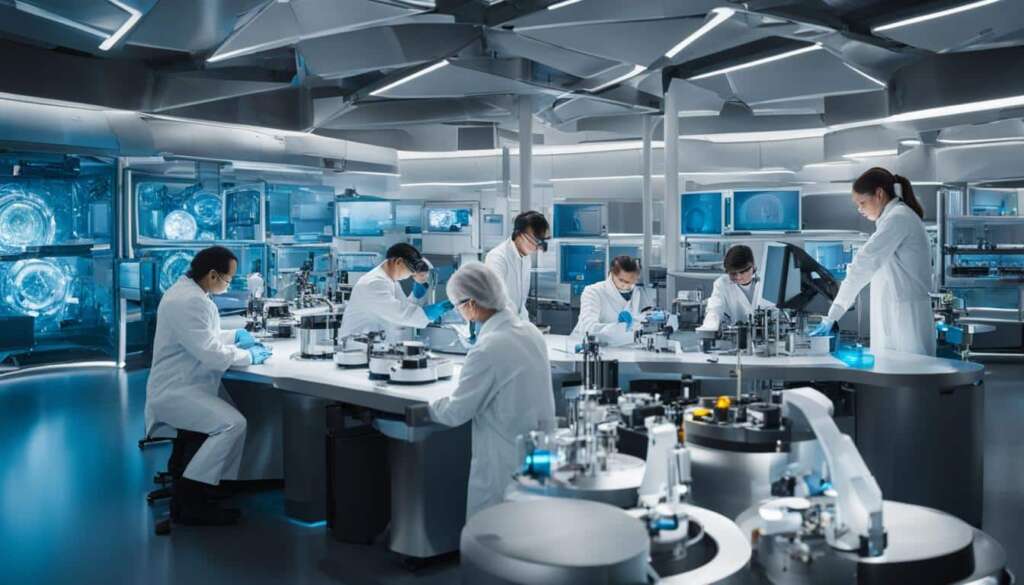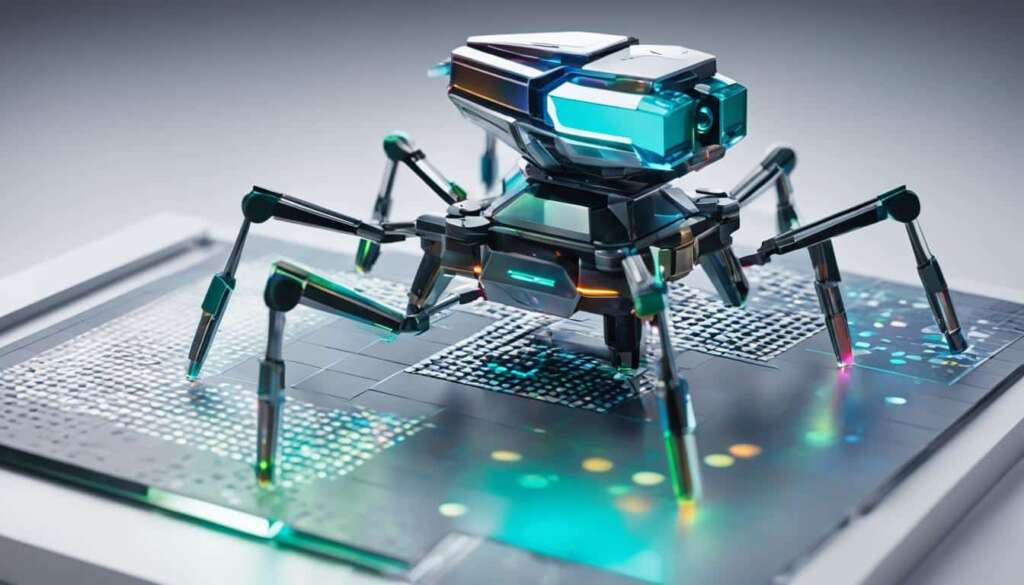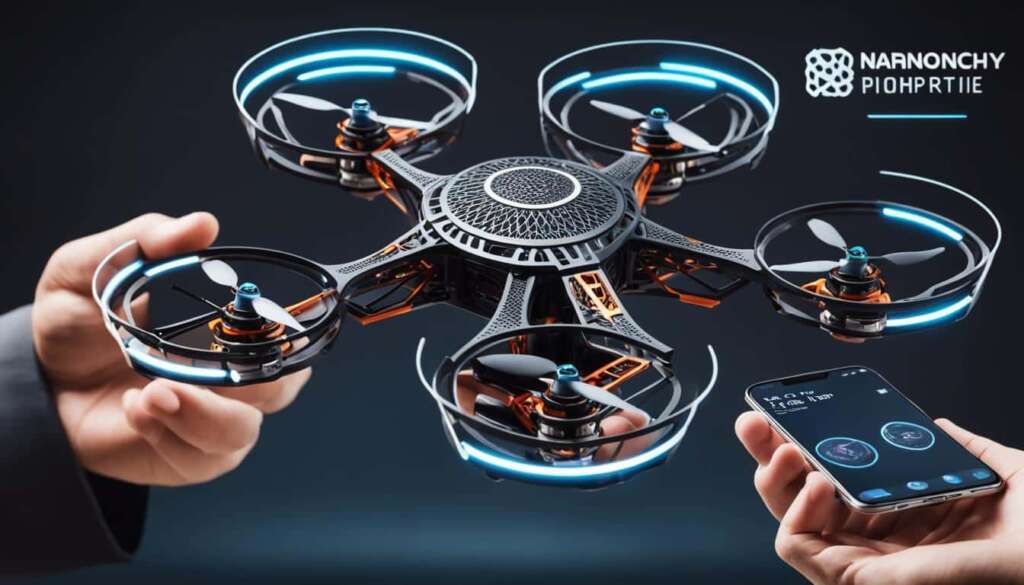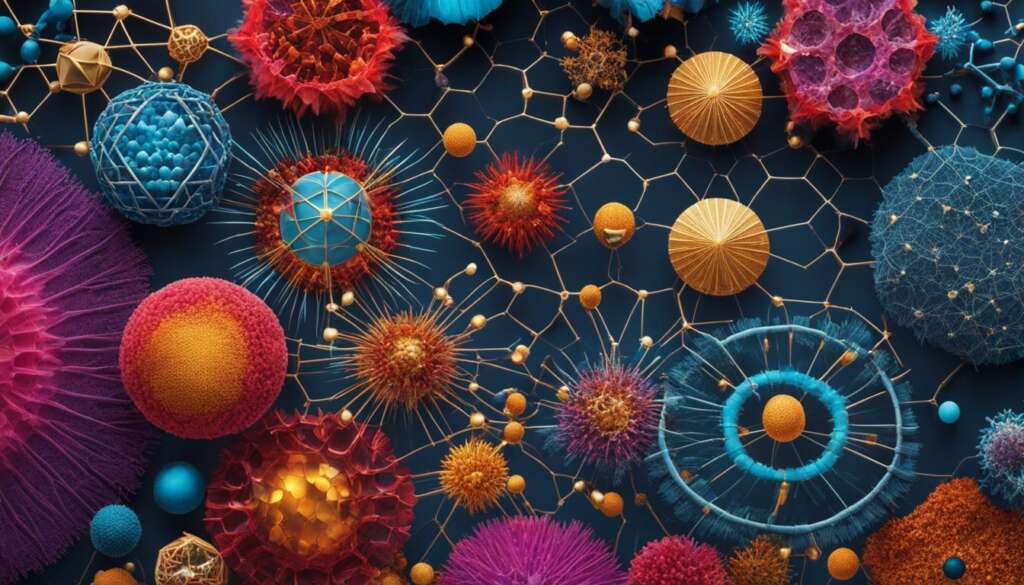Table of Contents
The food system is facing significant challenges, including population growth, urbanisation, ageing, sustainability, and climate change. These challenges have led to issues such as hunger, food waste, obesity, and foodborne diseases. To address these challenges, the food industry is turning to nanotechnology as a potential solution. The nanotechnology market for the food industry is expected to increase from 7 billion US dollars in 2015 to 20.4 billion US dollars in 2020. Nanotechnology offers various advantages in food production, such as improved solubility and bioavailability of bioactive compounds, better sensorial behaviour, and increased efficiency and selectivity in food processing operations.
Key Takeaways:
- Nanotechnology offers solutions to the challenges faced by the food system, such as hunger, food waste, and foodborne diseases.
- The market for nanotechnology in the food industry is expected to grow significantly.
- Nanotechnology improves the solubility and bioavailability of bioactive compounds and enhances sensory aspects of food.
- Nanotechnology can contribute to the development of sustainable and efficient food production methods.
- Effective communication and regulatory frameworks are crucial for the responsible use of nanotechnology in food.
Importance of Food Nanostructures
The unique characteristics of foods, particularly their micro and nanostructure, play a crucial role in determining their properties and technological aptitude. Nanotechnology in food processing leverages nanoscale structures to improve various aspects of food production, including solubility, bioavailability, protection against degradation, and modification of food characteristics.
Nanoscale Structures in Food
Nanoscale structures offer distinct advantages in the realm of food processing. These structures provide higher surface area, which enhances the interaction between food components and other substances. Furthermore, nanoscale structures exhibit unique optical behavior, chemical and kinetic stability, and low density, enabling new possibilities in food manufacturing.
Nanoscale structures in food processing operations can improve solubility and bioavailability of bioactive compounds, protect functional compounds against degradation, and modify food characteristics such as texture. Nanofibrils and nanostructured crystals are examples of structures that can be used to change food properties.
Improving Solubility and Bioavailability
One of the significant challenges in food processing is enhancing the solubility and bioavailability of bioactive compounds. Nanotechnology addresses this challenge by utilizing nanoscale structures to improve the dispersibility of these compounds in food matrices, ensuring their efficient absorption by the human body.
Protecting Functional Compounds
Functional compounds, such as vitamins and antioxidants, are susceptible to degradation during food processing and storage. Nanotechnology offers solutions to protect these compounds from degradation by encapsulating them within nanoscale structures. This encapsulation helps preserve the functional properties of these compounds, ensuring their effectiveness in food products.
Modifying Food Characteristics
The texture and sensory properties of food play a vital role in consumer acceptance and overall food experience. Nanotechnology allows for the modification of food characteristics by using nanostructured materials. These materials can enhance the texture, appearance, and taste of food products, creating novel sensory experiences for consumers.
To visualize the importance of nanoscale structures in food, consider the following table:
| Application | Benefits |
|---|---|
| Improved solubility and bioavailability | Enhanced absorption of bioactive compounds |
| Protection against degradation | Prolonged shelf life and preservation of functional compounds |
| Texture modification | Enhanced mouthfeel and sensory experience |
The table above illustrates the applications of nanoscale structures in food processing and the corresponding benefits. These applications demonstrate the significant impact nanotechnology can have on food production, improving various aspects of the final product.
Enhancing the Nutritional Value of Foods
Nanotechnology offers exciting possibilities for enhancing the nutritional value of foods. By harnessing nanotechnology, the stability and bioavailability of bioactive compounds can be increased, leading to improved health outcomes. One of the key applications of nanotechnology in food is nanoencapsulation.
Nanoencapsulation technologies involve the encapsulation of labile compounds, such as vitamins and antioxidants, in nanoscale carriers. These carriers protect the compounds from degradation, ensuring their potency and effectiveness. Additionally, nanoencapsulation enables a controlled release pattern, delivering the functional compounds to the human gut in a targeted manner.
This targeted delivery of bioactive compounds has profound implications for personalized nutrition schemes. With nanotechnology, it becomes possible to develop food products that meet specific health requirements. For example, a nanoencapsulated vitamin supplement can be designed to release nutrients at the optimal time and location in the digestive system, maximizing their absorption and bioavailability.
Emerging nanoencapsulation methods, such as nanospray-drying and electrohydrodynamic processing, offer further avenues for optimizing the nutritional value of foods. Nanospray-drying involves the conversion of liquid droplets containing bioactive compounds into solid particles with nanoscale dimensions. This encapsulation technique enhances the stability and dispersibility of the encapsulated compounds, improving their solubility and bioavailability.
Electrohydrodynamic processing, on the other hand, relies on an electric field to create and manipulate nanoscale structures. This method can be used to engineer nanostructured systems with tailored functionalities, enabling precise control over the release and bioavailability of bioactive compounds. By utilizing these emerging nanoencapsulation methods, the nutritional value of foods can be optimized, providing consumers with enhanced health benefits.
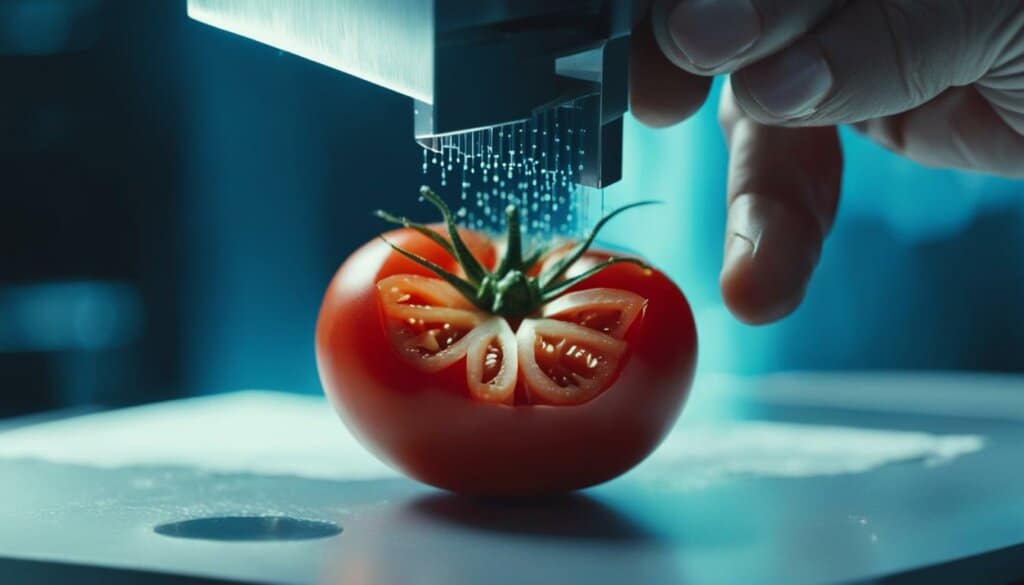
Nanotechnology has the potential to revolutionize the food industry and improve the nutritional value of our diets. With its ability to enhance the stability and bioavailability of bioactive compounds, nanotechnology opens up possibilities for personalized nutrition and the development of functional food products. As research and development in nanotechnology continue to advance, the future holds exciting opportunities for maximizing the nutritional benefits of our food.
Improving Food Safety
Nanotechnology has shown tremendous potential in enhancing food safety by preventing foodborne diseases and minimizing the risk of contamination. Through the application of nanotechnology, various innovative approaches have been developed to address key challenges in food safety.
Masking Off-Flavors and Enhancing Color
Nanoencapsulation is a technique that can be utilized to mask off-flavors and enhance the color of food products. By encapsulating volatile compounds responsible for unpleasant tastes or odors, nanocarriers can effectively minimize their impact on sensory quality. This allows for the production of more enjoyable and appealing food products.
Protection Against Degradation
Nanoencapsulation also plays a crucial role in safeguarding bioactive compounds during processing or cooking. Encapsulation technologies create a protective barrier around these compounds, shielding them from degradation caused by environmental factors, such as heat or oxygen exposure. This preservation ensures the retention of nutritional value and functional benefits in the final food product.
Efficiency and Selectivity in Food Processing
Nanotechnology offers the opportunity to improve the efficiency and selectivity of food processing operations through the use of nanostructured membranes. These membranes possess high surface area, enabling enhanced filtration and selective immobilization of enzymes. As a result, the removal of contaminants and the optimization of processing conditions are achieved, ensuring the quality and safety of the end product.
Detecting and Monitoring Contaminants
Nanotechnology-based sensors have emerged as powerful tools for the detection and monitoring of contaminants in food. These sensors harness the unique properties of nanomaterials to selectively identify harmful substances, such as pathogens or chemical contaminants. By providing rapid and accurate results, these sensors assist in maintaining the safety and integrity of the food supply chain.
Overall Benefits
| Benefits of Nanotechnology in Food Safety |
|---|
| Prevention of foodborne diseases |
| Reduction of contamination risks |
| Improved sensory quality |
| Preservation of bioactive compounds |
| Enhanced efficiency in food processing |
| Accurate detection of contaminants |
By harnessing the unique properties of nanotechnology, the food industry can elevate food safety standards and minimize the occurrence of foodborne diseases. Preventive measures, such as masking off-flavors, protecting bioactive compounds, improving processing efficiency, and implementing effective contaminant detection methods, collectively contribute towards establishing a safe and reliable food supply chain.
Sustainable Food Production
Nanotechnology offers tremendous potential for the development of more sustainable methods in food production, with the aim of reducing the environmental impact of agriculture and promoting a more resilient food system. By implementing nanotechnology, we can improve the efficiency of food processing operations, reduce waste, and minimize energy consumption. Additionally, nanoscale materials can serve as viable substitutes for traditional resources, contributing to the conservation of natural resources. This has a profound impact on the overall sustainability of food production.
Nanotechnology enables us to enhance agricultural practices by increasing their efficiency and stability. Through the use of nanosensors and advanced monitoring systems, we can optimize irrigation, fertilizer application, and pest control, leading to improved resource management and reduced environmental impact. Similarly, nanotechnology can facilitate controlled release mechanisms for fertilizers and pesticides, minimizing their overuse and potential harmful effects on ecosystems.
One of the key benefits of nanotechnology in sustainable food production is its potential to revolutionize water usage in agriculture. By employing nanomaterials and nanofilters, we can enhance water purification processes, leading to increased water availability for irrigation and reducing the strain on existing water resources. Given the rising concerns about water scarcity around the world, this application of nanotechnology is of immense significance.
Furthermore, nanotechnology offers the possibility of enhancing crop yields and food quality in a sustainable manner. By utilizing nanomaterials such as nanoparticles, nanofertilizers, and nanocoatings, we can improve nutrient uptake, disease resistance, and post-harvest shelf life of crops. These advancements contribute to the reduction of food waste and increase food availability, addressing the global challenge of feeding a growing population.

Nanotechnology in sustainable food production represents a revolutionary approach towards building a more environmentally friendly and resilient food system. By harnessing the potential of nanotechnology, we can minimize the ecological footprint of agriculture, conserve natural resources, and ensure food security for future generations.
Encouraging Innovation in the Food Industry
Nanotechnology is revolutionizing the food industry, fostering innovation and unlocking new possibilities for product development and enhancement. With its wide range of applications, nanotechnology has the potential to transform the way we produce, process, and package food. By leveraging the unique properties of nanoscale materials, the food industry can introduce new and improved food products that meet the evolving needs and preferences of consumers.
Nanotechnology offers numerous benefits for the production of food. By incorporating nanomaterials into food processing operations, manufacturers can optimize efficiency, improve quality control, and streamline production processes. For example, the use of nanoparticle-based additives can enhance the emulsification, stabilisation, and delivery of functional ingredients, resulting in improved product uniformity and shelf life.
Furthermore, nanotechnology enables the development of smart packaging solutions that actively monitor food quality, freshness, and safety. Nanosensors embedded in packaging materials can detect changes in temperature, humidity, and gas composition, providing real-time data on the condition of the food. This technology not only enhances the overall consumer experience but also helps reduce food waste by ensuring optimal storage conditions and timely consumption.
The Sensory Revolution
In addition to improving production processes and packaging, nanotechnology plays a key role in enhancing the sensory properties of food. By manipulating nanoscale particles, scientists have found ways to improve the taste, texture, and appearance of food products. For example, the use of nanoemulsion technology can create finer and more uniform structures, resulting in a smoother mouthfeel and improved flavour release. Nanoparticles can also be used to manipulate the optical properties of food, resulting in vibrant colours that are visually appealing to consumers.
“Nanotechnology is providing exciting new possibilities for enhancing the sensory attributes of food products. By harnessing the power of nanoscale materials, we can create a truly immersive dining experience that delights all the senses.”
– Dr. Emma Thompson, Food Scientist
Building Consumer Trust
As nanotechnology continues to drive innovation in the food industry, building trust among consumers is crucial. Transparent communication about the benefits and safety of nanotechnology-based products is essential to ensure their successful adoption. Informed consumers are more likely to embrace nanotechnology and appreciate its potential to improve their food experience.
The responsible use of nanotechnology in food should be guided by thorough safety assessments and regulatory frameworks. Stringent testing procedures and standards should be implemented to evaluate the potential risks associated with nanomaterials, ensuring that only safe and reliable products reach the market.
In summary, nanotechnology is a catalyst for innovation in the food industry, offering numerous applications that enhance production processes, packaging, and sensory experiences. By embracing nanotechnology, the food industry can unlock new frontiers of creativity and continue to meet the ever-changing demands of consumers.
Future Challenges and Opportunities
While nanotechnology offers promising solutions for the food industry, there are challenges that need to be addressed for its widespread adoption. Regulatory frameworks and safety evaluations need to be developed to ensure the safe use of nanotechnology in food. Public perception and acceptance of nanotechnology in food also need to be addressed through effective communication and transparency. Additionally, research and development efforts should focus on exploring new applications and further understanding the potential risks and benefits of nanotechnology in food.
Regulatory Frameworks and Safety Evaluations
One of the key challenges in the adoption of nanotechnology in food is the development of regulatory frameworks and safety evaluations. As nanotechnology continues to advance, it is crucial to establish guidelines and standards that ensure the safety and quality of nanotechnology-based food products. Comprehensive safety assessments should be conducted to evaluate the potential risks associated with nanomaterials, considering their toxicity and potential effects on human health and the environment.
Public Perception and Acceptance
Another challenge lies in addressing public perception and acceptance of nanotechnology in food. Effective communication and transparency are essential to build trust and confidence among consumers. Public awareness programs can educate consumers about the benefits and safety of nanotechnology-based food products, addressing any concerns or misconceptions they may have. By promoting openness and engagement, stakeholders can work together to overcome barriers and foster acceptance.
“The proper communication of nanotechnology in food is crucial for its successful integration into the market.”
Research and Development
Continued research and development efforts are vital to unlock the full potential of nanotechnology in food. By exploring new applications and conducting comprehensive studies, we can gain a deeper understanding of the benefits and risks associated with nanotechnology. This knowledge will guide the responsible development and utilization of nanotechnology in the food industry, addressing current challenges and paving the way for future opportunities.
To illustrate the importance of research and development, Table 7 provides an overview of ongoing projects and emerging innovations in the field of nanotechnology in food.
| Research/Innovation | Description |
|---|---|
| Smart Packaging | The development of packaging materials embedded with nanosensors for real-time monitoring of food quality and safety. |
| Nanosensors | The creation of nanosensors capable of detecting and identifying food contaminants, ensuring the safety of food products. |
| Targeted Delivery Systems | The utilization of nanomaterials to enable precise and controlled delivery of nutrients and bioactive compounds to specific sites in the body. |
With the continued advancement of nanotechnology, exciting opportunities for improving food production, safety, and nutrition are on the horizon. By addressing challenges, fostering innovation, and collaborating across sectors, we can navigate the evolving landscape of nanotechnology in food and unlock its full potential for a sustainable and resilient food system.
Consumer Awareness and Education
Consumer awareness and education are vital for the successful integration of nanotechnology in the food market. It is crucial to implement clear communication and transparent labeling to inform consumers about the presence and benefits of nanotechnology in food products.
Collaborative efforts between the food industry, academia, government, and consumer advocacy groups play a vital role in educating consumers about nanotechnology and addressing any concerns or misconceptions they may have.
By promoting consumer awareness, individuals can make informed decisions about the nanotechnology-based food products they purchase, supporting greater transparency and accountability within the industry.
Importance of Clear Communication and Transparent Labeling
Clear communication and transparent labeling are essential in ensuring consumer awareness of nanotechnology in food. They enable consumers to understand the presence of nanotechnology in food products and make informed choices based on their preferences and concerns.
Transparent labeling should provide comprehensive information about the use of nanotechnology, including the specific nanomaterials employed and their intended purposes. This enables consumers to assess potential benefits and risks associated with the product.
“Transparent labeling empowers consumers, allowing them to choose products aligned with their values and concerns.”
Collaborative Efforts in Consumer Education
To effectively educate consumers about nanotechnology in food, collaboration among various stakeholders is essential. The food industry, academia, government, and consumer advocacy groups should work together to develop educational initiatives that provide accurate and accessible information.
Partnerships between these stakeholders can establish educational campaigns, workshops, and online resources. These initiatives can help dispel misconceptions, answer questions, and foster a deeper understanding of nanotechnology’s role in food production.
Addressing Concerns and Misconceptions
Consumer education efforts should aim to address any concerns or misconceptions related to nanotechnology in food. Providing clear and scientifically accurate information can help build trust and confidence among consumers.
Open dialogues between stakeholders and consumers can facilitate the exchange of information and promote a better understanding of nanotechnology’s safety, benefits, and potential impacts on health and the environment.
Empowering Consumers through Knowledge
By enhancing consumer awareness and education about nanotechnology in food, individuals can make informed choices aligned with their preferences, values, and health needs. Knowledge empowers consumers to support responsible and sustainable practices within the food industry.
Education plays a crucial role in fostering a knowledgeable and engaged consumer base, driving demand for safe, innovative, and sustainable nanotechnology-based food products.
Ethical Considerations
The responsible use of nanotechnology in food requires careful consideration of ethical implications. As this technology continues to advance, it is crucial to address issues such as the equitable distribution of nanotechnology-based products, potential environmental impacts, and long-term health effects.
One of the key ethical concerns is ensuring fairness in the access and availability of nanotechnology-based food products. It is important to prevent disparities that could arise from unequal distribution, ensuring that the benefits of this technology are accessible to all segments of society.
Another critical aspect is the potential environmental impact of nanotechnology in food production. While nanomaterials offer numerous benefits, their long-term effects on ecosystems must be thoroughly evaluated and minimized to avoid unintended harm to the environment.
The long-term health effects of nanoparticles in food also require careful consideration. The potential risks associated with the ingestion of nanoparticles need to be comprehensively studied and addressed to ensure consumer safety.
To navigate these ethical considerations, robust governance systems, stakeholder engagement, and the development of ethical guidelines are paramount. Collaboration between policymakers, researchers, industry professionals, and consumer advocates is essential to establish frameworks that promote the responsible and sustainable use of nanotechnology in food.
“Ethical guidelines can help ensure that the responsible and sustainable use of nanotechnology benefits society as a whole.”
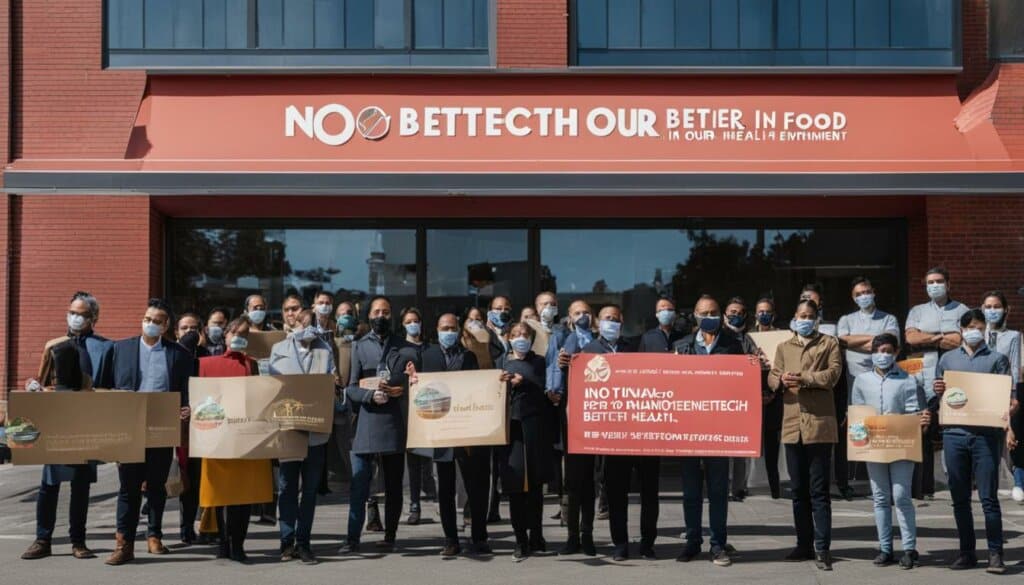
| Ethical Considerations | Implications |
|---|---|
| Equitable Distribution | Preventing disparities and ensuring access for all |
| Environmental Impact | Evaluating and minimizing potential harm to ecosystems |
| Long-Term Health Effects | Comprehensively studying and addressing potential risks |
| Governance Systems | Establishing robust frameworks for responsible use |
Regulatory Frameworks and Safety Assessments
Ensuring the safe use of nanotechnology in food requires the establishment of robust regulatory frameworks and comprehensive safety assessments. It is imperative to develop clear guidelines and standards that govern the safety and quality of nanotechnology-based food products. These frameworks should consider the potential risks associated with nanomaterials, including their toxicity and the possible effects on human health and the environment.
Safety assessments play a crucial role in evaluating the potential hazards and risks posed by nanotechnology in food. These assessments should encompass thorough examinations of the nanomaterials used, taking into account their physicochemical properties, degradation patterns, and potential interactions with the food matrix. Additionally, comprehensive toxicological studies should be conducted to assess the impact of nanomaterials on human health and the environment.
The Importance of International Collaboration
International collaboration and harmonization of regulations play a crucial role in ensuring the responsible adoption of nanotechnology in the global food industry. By working together, regulatory authorities can share knowledge, expertise, and best practices, leading to consistent and effective regulatory frameworks. Collaborative efforts also help address the challenges associated with the complex nature of nanotechnology, fostering global cooperation and facilitating the safe and sustainable use of nanotechnology in food.
“International collaboration is key to addressing the regulatory challenges of nanotechnology in food. By sharing information and resources, regulatory authorities can develop harmonized guidelines that ensure the safety and quality of nanotechnology-based food products.” – Dr. Elizabeth Wilson, Food Safety Expert
The Role of Safety Policies and Standards
Establishing safety policies and standards is essential in ensuring the responsible adoption of nanotechnology in food. These policies should incorporate risk assessment methodologies based on scientific evidence and input from experts in the field. By establishing clear safety criteria, regulators can effectively monitor and enforce compliance with these standards, safeguarding the health and well-being of consumers.
Moreover, ongoing research and development efforts should continue to contribute to the advancement of regulatory frameworks and safety assessments. As our understanding of nanotechnology evolves, it is essential to stay updated with emerging evidence and insights to refine and improve the existing safety standards. This iterative process will help address emerging concerns and potential risks associated with nanotechnology in food.
| Benefits of Regulatory Frameworks and Safety Assessments |
|---|
| Ensures the safety and quality of nanotechnology-based food products |
| Protects human health and the environment from potential risks |
| Promotes transparency and trust between stakeholders |
| Drives responsible adoption and innovation in the food industry |
Future Trends and Innovations
The future of nanotechnology in food holds exciting possibilities. Emerging innovations include the development of smart packaging materials that can monitor food quality and safety, the use of nanosensors for real-time detection of food contaminants, and the use of nanomaterials for targeted delivery of nutrients and bioactive compounds. As research and development in nanotechnology continue to advance, new opportunities for improving food production, safety, and nutrition are expected to emerge.
Smart packaging materials revolutionize the way we ensure food quality and safety. By integrating nanosensors into packaging materials, companies can monitor various factors such as temperature, humidity, and microbial contamination. These sensors provide real-time data and alert consumers and suppliers if there is a risk of spoilage or contamination. By ensuring the freshness and safety of food products, smart packaging materials play a crucial role in reducing food waste and protecting consumer health. As nanotechnology progresses, we can anticipate even more sophisticated and reliable monitoring systems.
Nanosensors are a game-changer in the food industry, allowing for accurate and rapid detection of food contaminants. These tiny devices can identify harmful bacteria, toxins, and allergens with high specificity and sensitivity. By implementing nanosensors at various stages of the supply chain, manufacturers can minimize the risk of foodborne illnesses and ensure the safety of the final product. Additionally, nanosensors can detect changes in food quality, such as the presence of rancidity or adulteration, enabling companies to maintain high standards and deliver superior products to consumers.
“Nanosensors enable real-time detection of food contaminants, ensuring the safety and quality of food products.”
Nanomaterials hold immense potential for targeted delivery of nutrients and bioactive compounds. By encapsulating these substances within nanoparticles, we can improve their stability, solubility, and bioavailability. This opens up avenues for personalized nutrition, allowing individuals to receive precise and tailored doses of vitamins, minerals, and other beneficial compounds. Nanomaterials can also enhance the efficiency of nutrient absorption in the body, maximizing the benefits derived from food. As nanotechnology continues to advance, we can expect breakthroughs in targeted nutrient delivery systems, leading to improved health outcomes.
The future trends in nanotechnology in food demonstrate the vast potential and transformative impact of this field. With the development of smart packaging materials, nanosensors, and nanomaterials for targeted delivery, we can envision a future where food is safer, more nutritious, and better suited to individual needs. As researchers and innovators continue to push boundaries, the possibilities for improving food production, safety, and nutrition are limitless.
Conclusion
Nanotechnology has the potential to revolutionize the food industry. By leveraging the unique properties and applications of nanoscale materials, nanotechnology can address key challenges in food production, safety, and nutrition. Through nanoencapsulation technologies, the nutritional value of foods can be enhanced by protecting labile compounds and delivering functional compounds with controlled release patterns.
In addition, nanotechnology can improve food safety by preventing foodborne diseases and reducing the risk of contamination. Nanostructured membranes and nanotechnology-based sensors enable more efficient and selective food processing operations, ensuring the safety and quality of the final product. Furthermore, nanotechnology offers opportunities for sustainable food production by improving processing efficiency, reducing waste, and substituting traditional resources.
However, the responsible adoption of nanotechnology in the food industry requires effective communication, transparent labeling, and robust regulatory frameworks. Public awareness and education about nanotechnology in food are crucial for its successful integration into the market. Ethical considerations, such as equitable distribution, environmental impacts, and long-term health effects, should also be carefully addressed. With continued research and development, nanotechnology holds great promise for shaping the future of nutrition and food systems.
FAQ
What is nanotechnology in food?
Nanotechnology in food refers to the application of nanoscale materials and structures in the production, processing, and packaging of food. It involves manipulating particles and structures at the nanoscale to enhance food properties, improve nutrition, ensure food safety, and promote sustainability.
How does nanotechnology improve the nutritional value of foods?
Nanotechnology can enhance the nutritional value of foods by improving the stability and bioavailability of bioactive compounds. Nanoencapsulation technologies can protect labile compounds such as vitamins and antioxidants, allowing them to be delivered to the human gut with a controlled release pattern. This enables the development of personalized nutrition schemes and food products that meet specific health requirements.
Can nanotechnology help improve food safety?
Yes, nanotechnology can contribute to improving food safety. Nanoencapsulation can be used to mask off-flavors and enhance the color in foods, as well as protect bioactive compounds from degradation during processing or cooking. Additionally, nanotechnology-based sensors can detect and monitor contaminants in food, ensuring the safety and quality of the final product.
How does nanotechnology promote sustainable food production?
Nanotechnology improves the efficiency of food processing operations, thereby reducing waste and energy consumption. Nanoscale materials can also be used as substitutes for traditional resources, contributing to the preservation of natural resources and reducing the environmental impact of agriculture. Furthermore, nanotechnology enhances the efficiency and stability of agricultural practices, ensuring a more sustainable and resilient food system in the face of climate change.
What are some applications of nanotechnology in the food industry?
Nanotechnology-based applications in the food industry include improving food production, processing, and packaging. It can lead to the development of new and improved food products, enhance sensory properties, and enable real-time detection of food contaminants. Nanotechnology also enables the targeted delivery of nutrients and bioactive compounds, as well as the development of smart packaging materials for monitoring food quality and safety.
What challenges and opportunities are associated with nanotechnology in food?
The widespread adoption of nanotechnology in food requires addressing challenges such as regulatory frameworks, safety evaluations, public perception, and research and development efforts. However, the future opportunities include developing innovative food products, improving food safety and nutrition, and advancing sustainable food production methods.
How can consumers be informed about nanotechnology in food?
Consumer awareness and education about nanotechnology in food are crucial. Clear communication and transparent labeling should be implemented to inform consumers about the presence and benefits of nanotechnology in food products. Collaborative efforts between the food industry, academia, government, and consumer advocacy groups can play a vital role in educating consumers and addressing any concerns or misconceptions they may have.
What ethical considerations should be taken into account when using nanotechnology in food?
The responsible use of nanotechnology in food requires careful consideration of ethical implications. Issues such as the equitable distribution of nanotechnology-based products, potential environmental impacts, and long-term health effects need to be addressed. Robust governance systems, stakeholder engagement, and ethical guidelines can help ensure that nanotechnology in food is used in a responsible and sustainable manner.
How are regulatory frameworks and safety assessments implemented for nanotechnology in food?
Regulatory frameworks and safety assessments are essential for the safe use of nanotechnology in food. Clear guidelines and standards should be developed to ensure the safety and quality of nanotechnology-based food products. Safety assessments should consider the potential risks associated with nanomaterials, including their toxicity and effects on human health and the environment. International collaboration and harmonization of regulations can facilitate the responsible adoption of nanotechnology in the global food industry.
What are the future trends and innovations in nanotechnology for food?
The future of nanotechnology in food holds exciting possibilities. Emerging innovations include the development of smart packaging materials for monitoring food quality and safety, the use of nanosensors for real-time detection of food contaminants, and the targeted delivery of nutrients and bioactive compounds. Ongoing research and development in nanotechnology are expected to lead to new opportunities for improving food production, safety, and nutrition.



